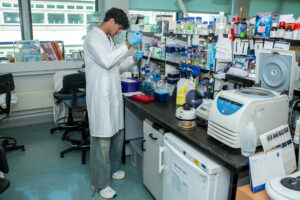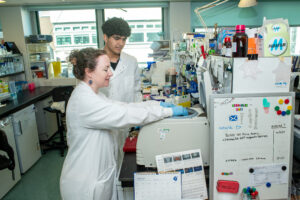My work experience week in a lab

Rohit Gopalkaje recently graduated from Boroughmuir High School and is going to study Medicine at the University of Edinburgh. Here he talks about his experience of gaining work experience in a lab at IGC.
Gaining a work experience placement
I reached out to the IGC to gain hands-on experience of what it is like to work in a laboratory and develop lab skills that would be useful for me in the future. I found Professor Caceres’ lab through the University website and was pleasantly surprised by how straightforward the process of securing a placement was as after sending an initial email, I received a prompt response. Over the week, I mainly worked on two experiments (see below) and I had the opportunity to attend various lectures and seminars by a wide range of researchers during the breaks from my experiments. A seminar about the Newborn Genomes Programme by Dr David Bick was one that I found most interesting (unsurprisingly as I am going into medicine).
Experiments
 The first experiment I took on was involving tissue culture of different cell lines (HepG2, HeLa and U2O). The experiment was to investigate the inhibition of the SMG1 protein on the Nonsense mediated decay (NMD) pathway. An SMG1 inhibitor was used, and the cells were tagged with GFP and mScarlet (fluorescent tags) to be able to see whether the NMD pathway had been activated by using techniques such as flow cytometry to assess the levels of fluorescence in the cells. RNA can be extracted from the cells and converted into cDNA using reverse transcriptase. This can be used in qPCR followed by double delta Ct analysis to determine the difference in the level of gene expression from the drug-treated cells to the control cells. This experiment allowed me to learn lab techniques such as extracting RNA from cells using an RNA extraction kit (RNeasy kit), and how qPCR works and how to perform its double delta Ct analysis.
The first experiment I took on was involving tissue culture of different cell lines (HepG2, HeLa and U2O). The experiment was to investigate the inhibition of the SMG1 protein on the Nonsense mediated decay (NMD) pathway. An SMG1 inhibitor was used, and the cells were tagged with GFP and mScarlet (fluorescent tags) to be able to see whether the NMD pathway had been activated by using techniques such as flow cytometry to assess the levels of fluorescence in the cells. RNA can be extracted from the cells and converted into cDNA using reverse transcriptase. This can be used in qPCR followed by double delta Ct analysis to determine the difference in the level of gene expression from the drug-treated cells to the control cells. This experiment allowed me to learn lab techniques such as extracting RNA from cells using an RNA extraction kit (RNeasy kit), and how qPCR works and how to perform its double delta Ct analysis.
 The second experiment I took part in was bacterial cloning. First, our required gene was inserted into a vector, in this case a bacterial plasmid. This was done using the CRISPR-Cas9 system. This plasmid was introduced into bacterial cells using the process of heat-shocking, where a sudden increase in temperature causes transient pores to form, which allows the modified plasmids to enter the cell. The new transformed recombinant bacteria are plated on an agar plate to allow colonies to grow. The next step is choosing colonies. The gene that we inserted was intended to disrupt a gene called LacZa in the plasmid. LacZa produces proteins that react with β-galactosidase in the agar plate leading to a blue colour, but after recombination the LacZa gene is disrupted, causing the colour to be white. This process is called blue-white screening, and we select the white colonies as we know these bacteria have plasmids that have picked up the required genes. After selection, they are put in a growth broth to incubate. Once incubated, the recombinant plasmids are extracted using a DNA extraction kit.
The second experiment I took part in was bacterial cloning. First, our required gene was inserted into a vector, in this case a bacterial plasmid. This was done using the CRISPR-Cas9 system. This plasmid was introduced into bacterial cells using the process of heat-shocking, where a sudden increase in temperature causes transient pores to form, which allows the modified plasmids to enter the cell. The new transformed recombinant bacteria are plated on an agar plate to allow colonies to grow. The next step is choosing colonies. The gene that we inserted was intended to disrupt a gene called LacZa in the plasmid. LacZa produces proteins that react with β-galactosidase in the agar plate leading to a blue colour, but after recombination the LacZa gene is disrupted, causing the colour to be white. This process is called blue-white screening, and we select the white colonies as we know these bacteria have plasmids that have picked up the required genes. After selection, they are put in a growth broth to incubate. Once incubated, the recombinant plasmids are extracted using a DNA extraction kit.
Supportive staff
I thoroughly enjoyed both learning about and carrying out these experiments. Over the course of the week, I grew much more confident in the lab environment and became comfortable handling a variety of scientific equipment. My supervisors and other staff were incredibly supportive, approachable and happy to explain anything I didn’t understand or needed clarified. Since day one, they made me feel like a part of their team. There isn’t anything I did not like about this placement other than how confusing navigating through the building for the first time was!
I would highly recommend this placement to any student considering a path in STEM; it offers invaluable hands-on experience and an insight into real-world scientific research.



